
Charting the whites and the reds: Boatie’s guide to the right wine
by Boat Gold Coast Team November 7, 2015His opinions might surprise you, for Chris Morgan of Wine Freaks in Hope Island believes that, “Gone are the days you have to drink a specific wine with a particular food. Therefore, the wine choice for different cooking methods like BBQ fish, fried fish, grilled fish, baked fish and smoked fish is totally up to you. If you enjoy a Shiraz with fish, you are not a crazy person who needs a strait jacket. Likewise, if you enjoy pinot noir with no shirt on then go nuts. The best advice is try a few and find an awesome wine just for you.”
On choosing the right wine. “Firstly, the wine must not ‘dominate’ your food—it should enhance the experience.” The wine Chris recommends with fish caught locally on the Gold Coast is, “A Semillon/Sauvignon Blanc, or as some call it a fresh dry white. Semillon gives a lovely body to the style and offers a bit more than your straight Sauvignon Blanc. St Hallett Poachers Sem/Sav at $16.99 is of good value and a great Aussie.”
He advises that the ideal wine to drink while on a boat in the hot summer sun of November to January is the favoured standard Shaw and Smith’s Sauvignon Blanc (Adelaide hills) 2015 at $29.00, “arguably Australia’s best for a white wine.” He recommends Charles Melton’s Rosé of Virginia Rosé at $25.00 for a red. “This is a lovely dry style rosé from the Barossa, and consistently judged amongst the finest rosé’s in the country. I myself find heavy reds do not go well in heavy seas.”
When it comes to combining these two wines with a meal onboard, Chris offers, “A fine coupling with Shaw and Smith chilled would be fresh calamari and lightly battered whiting fillets, no salad required. The Melton rosé chilled would go swimmingly with chili mud crab or any Asian dish.”
That right temp. The proper temperature to consume wine is a hotly debated issue. To settle the matter, Chris shares his wisdom. “All white wine should be served chilled at 4 degrees Celsius, except Chardonnay and Riesling. These should be served at 10 degrees Celsius. Red wine should be served at ‘room temperature’. This is confusing and vague at best. Red wine should be served and maintained at around 18 degrees Celsius. If your red wine gets to 30 degrees, the flavours will be lost, muddled and jam-like. However, rosé and pinot noir should be served between 11 and 18 degrees Celsius. It is generally hotter in Queensland and a lower serving temperature is best, as once it is in the glass it will rise quickly. Always remember that ‘room temperature’ is where the grapes are grown not your room.”
Age, please? Knowing at what vintage to consume your wine is vital. Chris advises, “White wine generally needs to be young and fresh, although Rieslings from Clare and Eden Valley can age beautifully for decades. Generally, white wine should be no more than three years old on the bottle for Pinot Gris, Sauvignon Blanc and Verdelho. While more than three years for Chardonnay or Semillon. Red wine needs to be aged (over three years). A 2014 or 2015 red is still a bit green for a heavy red. That is as general as it gets. To be correct across all wines, every bottle’s ideal vintage to consume will have a specific consideration.”
On storing wine. “How long you can keep a sealed bottle of wine depends on your cellaring/storage options,” according to Chris. “Fluctuations in temperature are fatal to your wine. Wines with higher alcohol content (15% to 16%) do not last as long as lower alcohol wines. Most wine benefits from some cellaring (including whites) but 95% of wine sold will be consumed immediately.”
Advice on drinking. Speaking from experience, Chris shares, “Scientifically, when drinking wine you might experience a headache because your brain swells and puts pressure on the fluid between your brain and skull. If you continue drinking you will go into a mild psychosis. Otherwise, you may be experiencing an allergic reaction to the sulphites added to the wine to preserve it. Sulphites have been used in allowing wine to age since early Roman times. These are most commonly known on the bottle as preservatives 220 to 228. However the reaction to the preservatives is almost immediate so if you are getting a headache on the second bottle, then have some water and a time out.”
Cost considerations. How much do you need to spend on a good bottle of wine is always a point of contention. Chris estimates, “I average that any single person will spend $1,000.00 in entry level wines ($10-$15 per bottle) in order to find that cheap wine that ticks most of their boxes. My favourite red is Stump Jump GSM from D’arenberg at $12.99. To nail it down, there are so many great Aussie wines for around $20. Entry level Aussie wines have improved in quality over the last 10 years, so much so that the are getting multiple medals around Oz.”
Top 3 wine picks for summer:
Josepf Chromy Pepik Pinot Noir ($16.99)
Vidal Sauvignon Blanc ($12.99)
Charles Melton Rosé of Virginia ($25.00)




























